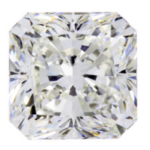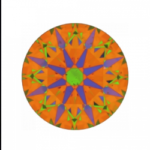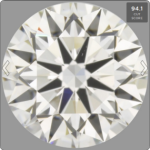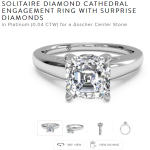When a diamond is graded according to its clarity, a gemologist will inspect the diamond for inclusions (in the diamond) and blemishes (on the diamond’s surface). These inclusions and blemishes can occur in any number and any size. The gemologist will also inspect the color of the inclusions (white, gray, or black), their relative location, orientation and visibility. They will then come up with a diamond clarity grade for the diamond as it is viewed under 10x’s magnification.
Diamond Clarity Grades, ‘Eye-Clean’, and ‘Prongable’
The gemologist assesses the diamond on the basis of the most noticeable inclusions or “grade setting inclusions”. This means that less significant inclusions are ignored when setting the clarity grade, but they may be included on a diamond’s plot diagram.
A diamond’s clarity grade is always based on 10x’s magnification. Many people don’t realize this. This is in fact how GIA and AGS grade clarity in a diamond. A diamond with no inclusions or blemishes is considered Flawless. These diamonds are extremely rare. It is more common to find internally flawless, which is when the diamond may have some external blemishes or polishing marks but no internal inclusions. Diamonds with these clarity grades are often purchased for investment or personal collection.
Next we give a clarity grade of VVS1 or VVS2 to diamonds where we can just barely see inclusions under 10x’s magnification. Even with a jewelers loupe it is very very difficult to see any inclusions. Many labs use higher magnification in order to plot these miniscule inclusions accurately. These diamonds are absolutely 100% eye-clean.
A VS1 and VS2 is still very difficult to find and locate inclusions under 10x’s magnification. Diamonds with these clarity grades are a great way to save cash while ensuring that your diamond will still be eye-clean.
SI1 and SI2 clarity graded diamonds have inclusions that are easier to detect using 10x’s magnification. However, these clarity grades are not necessarily eye-clean. Each diamond must be evaluated on it’s own personal merit.
Finally, we have inclusions that are visible to the naked eye without any magnification at all, and these are graded I1 to I3. ODBA’s diamond search goes as low as I1 because diamonds that are I2 and lower can sometimes have durability or structural integrity risks which are better off seen and evaluated in person.
Although very reputable labs such as GIA or AGS have stringent criteria for assessing a diamond’s clarity grade, this process is a human process and is therefore ultimately subjective. Each diamond is unique and therefore one SI1 isn’t the same as another SI1. That is why magnified diamond images are helpful in discovering where an inclusion lies and if it is satisfactory to an individual. Everyone has their own tolerances of what they consider acceptable.
It is important to understand that most inclusions in gem-quality diamonds DO NOT affect it’s performance or structural integrity. The only two issues to concern yourself with would be either: large feathers on or near the girdle or reaching the surface, as these may have a higher propensity to fracture. Large clouds (clouds are clusters of tiny pinpoints that can appear exactly as they are named; cloudy) can also affect how a diamond transmits and scatters light, therefore making the stone look fuzzy.
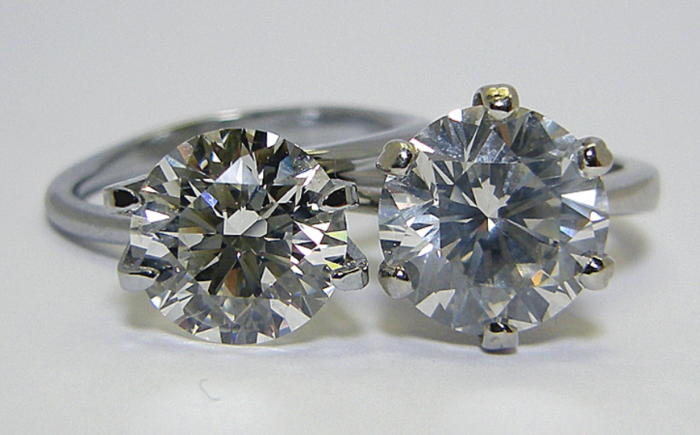
SI2 Diamond on the left, Cloudy I1 Diamond on the Right (cloud covers more than 2/3 of the diamond) – It is important to note that the diamond on the right was originally graded as VS2 from a Middle East Lab with an unknown certificate.
In the diamond industry, a diamond may have any of the following:
Internal Inclusions – internal inclusions: crystal, cloud, bruise, twinning wisp, cleavage, cavity, knot, indented natural, pinpoint, feather, needle, chip, bearding, internal graining, and laser drill hole
External Blemishes – natural, surface grain line, polishing line, extra facet, and scratch
And the above inclusions/blemishes are then graded according to the following clarity grades:
Diamond Clarity Grades

Diamond clarity scale – courtesy of Whiteflash.com
- F
Flawless: No internal or external flaws visible under 10x. Extremely rare. - IF
Internally Flawless: no internal flaws, but some surface blemishes under 10x. Very rare. - VVS1-VVS2
Very Very Slightly Included, diamonds have minute inclusions that are very difficult for a skilled grader to see under 10x. These usually include pinpoints and needles. - VS1-VS2
Very Slightly Included, diamonds have minor inclusions that are difficult to somewhat easy for a trained grader to see when viewed under 10x. These inclusions are typically invisible without any magnification. However, sometimes some VS inclusions may still be visible to the naked eye depending on the diamond’s cut and where the inclusion is located. - SI1-SI2
Slightly Included, minute inclusions that are easy to locate and see when viewed under 10x magnification. These may or may not be noticeable to the naked eye. - I1-I2-I3
Included, obvious inclusions that are visible to a trained grader under 10x magnification. Some diamonds have inclusions that are visible without magnification or have inclusions that threaten the durability of the diamond.
The only difference to the above grades is with reference to AGS or The American Gem Society. This lab grades clarity on a number scale between 0 and 10. There are some minor difference to the GIA scale referred to above. For example, the flawless and internally flawless (grade 0) are grouped together, with a difference being whether a diamond is free from external flaws. The VVS through SI grades are numbered 1 through 6. The I grade is numbered 7-10.

Most seem to think that clarity grade affects brilliance or sparkle. However, this isn’t the case as I have already mentioned above. It is a diamond’s cut that determines overall brilliance and light reflection. Inclusions aren’t ‘bad’ but rather they are what make a diamond uniquely yours.
What’s An ‘Eye-Clean’ Diamond?
Eye-clean diamonds are an industry term used to define diamonds that have inclusions that aren’t visible to the naked eye usually from 10-12 inches when looking straight down into the diamond’s crown. You’ll want to evaluate a particular stone’s clarity based on the following 6 areas:
#1. Your Eyesight
#2. Lighting
#3. Nature of the inclusion(s)
#4. Where the inclusion is located on/in the diamond
#5. Size of the inclusion
#6. Face up view (when looking straight down at diamond) and pavilion or side view
The following pictures are representative of some of the available diamonds found on JamesAllen.com. Keep in mind that all diamonds are unique so this diamond clarity chart is to be used as a general educational guide to help you understand how diamonds are graded for clarity and what is acceptable to buy. Obviously some diamonds are acceptable as “eye-clean“stones and some are clearly not. Each actual diamond picture is magnified.
Diamond Clarity Chart
Not An Eye-Clean I1 Diamond
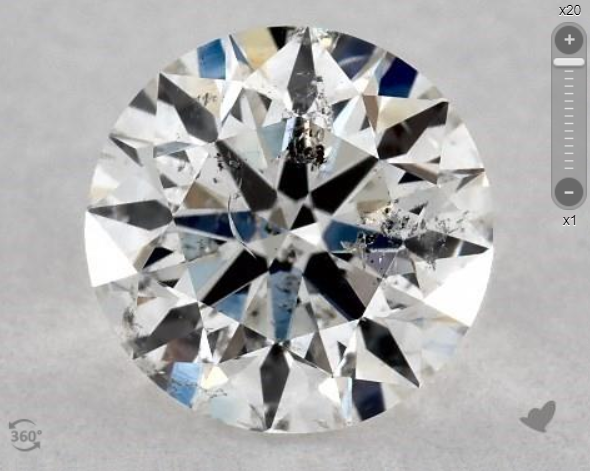
A .70ct G with I1 clarity diamond. The dark crystal inclusions are clearly visible without any magnification.
Eye-Clean or “Prongable” I1 Diamond
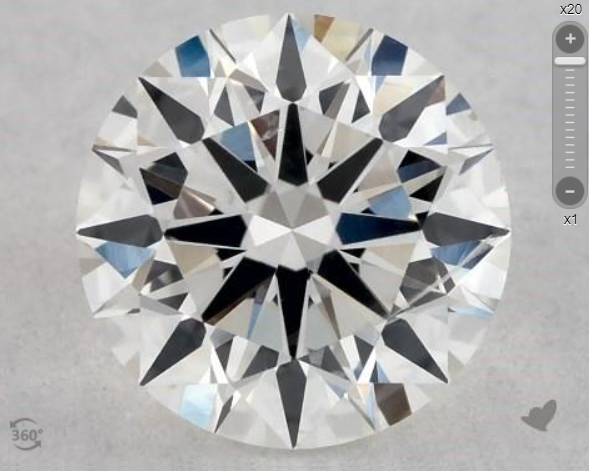
A .51ct G with I1 clarity. In this example the inclusion is a large white/grayish feather that is primarily located under the star and kite facets. This inclusion may be acceptable to some as the inclusion is gray to white and can be covered by a prong in a jewelry setting.
Not An Eye-Clean SI2 Diamond
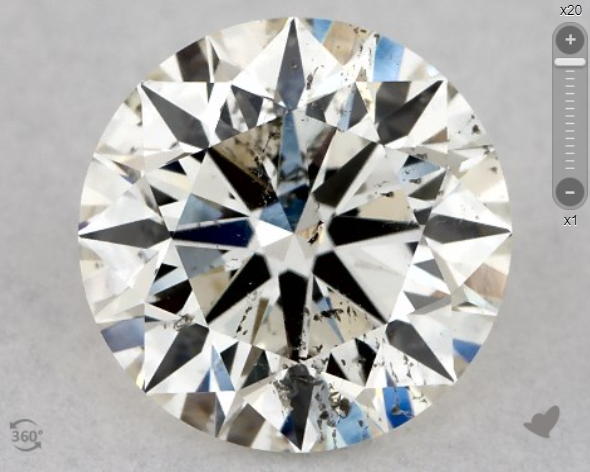
A .74ct K with SI2 clarity. The inclusions are black and gray crystals that are easy to see under the entire crown of the diamond.
Eye-Clean SI2 Diamond
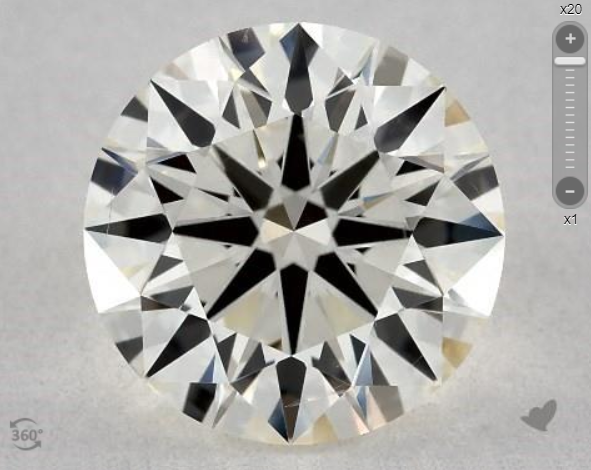
A 1.01ct with SI2 clarity. This is a perfect example of an “eye clean” stone. Can you see the inclusions?
Not An Eye-Clean SI1 Diamond
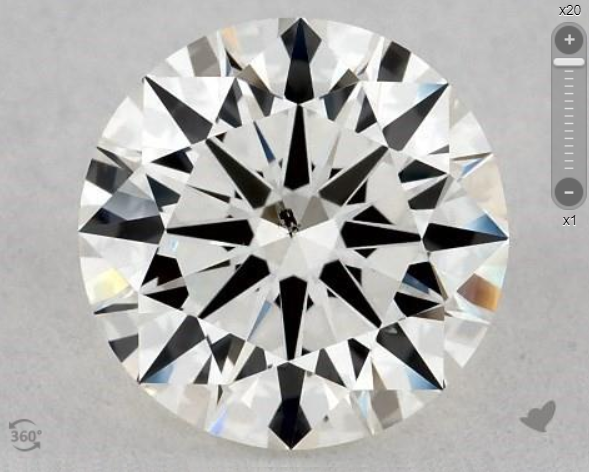
A 1.08ct with SI1 clarity. There is just one noticeable dark crystal under the table, and for this reason it has been given an SI1 clarity grade.
Eye-Clean SI1 Diamond
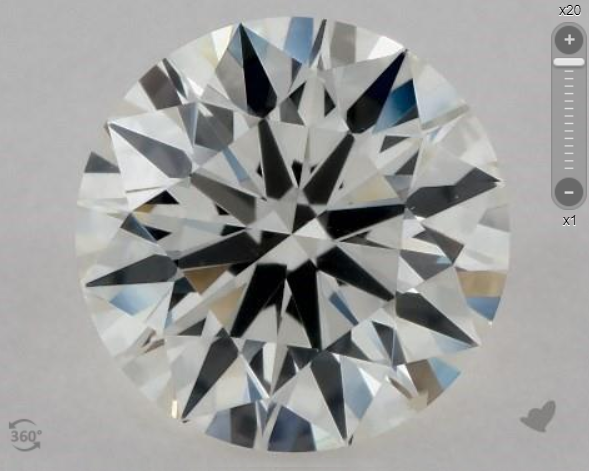
A .90ct H with SI1 clarity. A perfect example of an eye-clean diamond.
Somewhat Eye-Clean VS2 Diamond
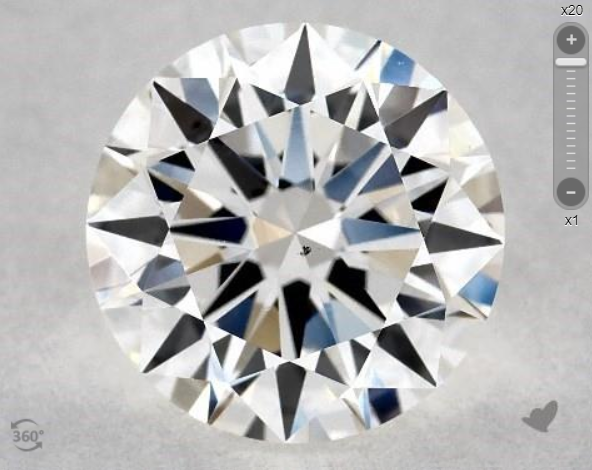
A 1.11ct F with VS2 clarity. The inclusion is under the table facet. For a very small group of people, this diamond may not be eye-clean, although this would be rare.
As you can see from the magnified pictures of actual diamonds above, clarity grades can vary wildly depending on the aforementioned six areas. Laboratories have specific criteria for clarity grading which depends on a diamonds inclusions (white, gray, or black), their relative location, orientation and visibility.
As demonstrated above, you can find a reasonably good I1 diamond and a great eye-clean SI2 diamond. On the other hand, you cannot always depend on a VS2 being completely eye-clean as it can depend on the type of inclusion and where it is located. So in other words, always ask the diamond retailer if the diamond is eye-clean and what kind of inclusions are in/on the diamond.
‘Prongable’ Diamonds
Some people have very limited budgets and want to buy an excellent quality stone but can compromise a little on other characteristics in order to save even more money. In these cases, diamonds with a visible inclusion are sometimes considered “prongable” when the inclusion can be easily covered by a jewelry setting prong. In the examples above, the prongable I1 diamond would be a perfect example of this.
You don’t need to buy a diamond that has a very high clarity grade in order to purchase a beautifully stunning diamond. Remember, cut grade is what determines brilliance and sparkle.
If you are ready to get some diamond recommendations, please contact me. I look forward to hearing from you!
Happy Diamond Buying!
ODBA Recommends
You May Also Like




